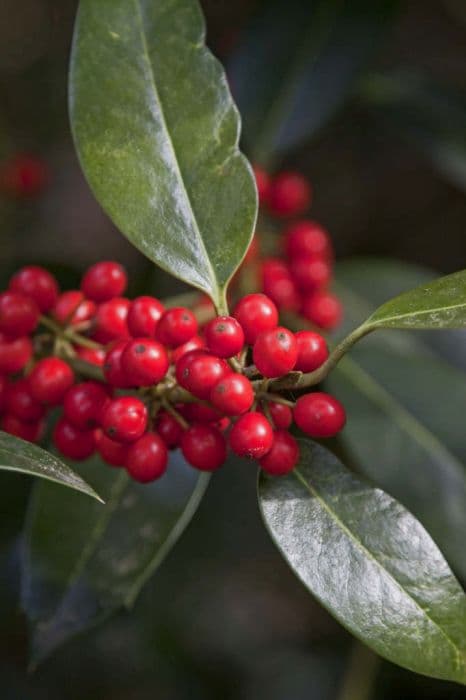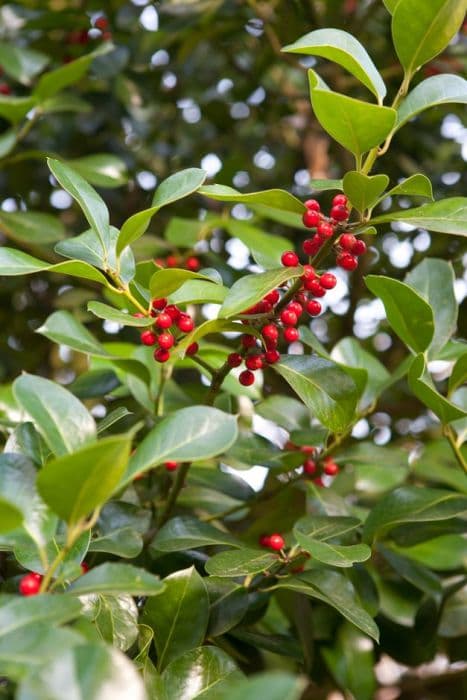Silver Milkmaid Holly Ilex aquifolium 'Silver Milkmaid' (f/v)

ABOUT
The Silver Milkmaid is a striking variety known for its variegated foliage that brings a unique aesthetic to gardens and landscapes. This plant is a member of the holly family and is characterized by glossy leaves that have a distinctive spiny, wavy edge. Each leaf exhibits a creamy-white or silver margin that contrasts beautifully with the dark green centers, giving the foliage a shimmering appearance that can brighten up any garden space. During the colder months, the plant draws attention with its vibrant red berries, which provide a festive touch and are a source of food for birds. These berries usually emerge in the company of the plant's small white flowers that make an appearance earlier in the year. The Silver Milkmaid is often used as an ornamental plant for its striking variegated leaves and the seasonal interest it brings throughout the year.
About this plant
 Names
NamesFamily
Aquifoliaceae
Synonyms
Silver Milkmaid Holly, Variegated English Holly, Silver Variegated Holly
Common names
Ilex aquifolium 'Silver Milkmaid'
 Toxicity
ToxicityTo humans
The common name for Ilex aquifolium 'Silver Milkmaid' is the English Holly. English Holly is toxic to humans if ingested. The plant contains saponins and other compounds that can cause symptoms such as nausea, vomiting, diarrhea, and abdominal pain. In severe cases, dehydration or drowsiness could potentially occur from substantial ingestion of the leaves or berries. It is particularly important to ensure that children do not eat any part of the plant, as the bright berries can be attractive but are harmful if swallowed.
To pets
The common name for Ilex aquifolium 'Silver Milkmaid' is the English Holly. English Holly is toxic to pets, including dogs and cats. If pets ingest the leaves or berries, they may experience symptoms such as vomiting, diarrhea, drooling, and decreased appetite. In severe cases, ingestion can lead to drowsiness, dehydration, or more serious effects, depending on the amount consumed. It is advisable to keep this plant out of reach of pets and to monitor them for any signs of distress if they are known to have chewed on or eaten any part of the plant.
 Characteristics
CharacteristicsLife cycle
Perennials
Foliage type
Evergreen
Color of leaves
Variegated
Flower color
White
Height
6-10 feet (1.8-3 meters)
Spread
6-10 feet (1.8-3 meters)
Plant type
Shrub
Hardiness zones
5-9
Native area
Europe
Benefits
 General Benefits
General Benefits- Attractive Foliage: Ilex aquifolium 'Silver Milkmaid', commonly known as the English Holly, has variegated leaves that add visual interest to gardens throughout the year.
- Winter Interest: The plant bears colorful berries against green and silver variegated foliage, providing color in the winter garden when many other plants are dormant.
- Habitat for Wildlife: The berries provide a food source for birds during the cold months when food is scarce, and the dense foliage offers shelter.
- Low Maintenance: English Holly is known for being robust and requiring minimal care once established, making it suitable for gardeners seeking low-maintenance plants.
- Drought Tolerance: Once established, it has good resistance to drought, reducing the need for frequent watering.
- Versatile Landscaping: It can be used for hedging, screens, as a specimen plant, or for topiaries, providing flexibility in garden design.
- Evergreen Nature: Being an evergreen, it retains its leaves throughout the year, ensuring the garden remains lively even in winter.
- Privacy Screen: With its dense growth habit, it can effectively be used for privacy screening.
- Long-Lived: English Holly is known to be a long-lived plant, contributing to a stable garden environment and reducing the need for frequent replanting.
 Medical Properties
Medical PropertiesThis plant is not used for medical purposes.
 Air-purifying Qualities
Air-purifying QualitiesThis plant is not specifically known for air purifying qualities.
 Other Uses
Other Uses- Holly 'Silver Milkmaid' is often used in winter holiday decorations due to its festive appearance with variegated leaves and red berries.
- Spiny leaves of Holly can serve as a natural deterrent for pets and wildlife that might otherwise damage garden areas.
- When dried and powdered, Holly leaves have been used as a natural abrasive ingredient for polishing metal or wood.
- Holly wood is very dense and fine-grained, making it suitable for making chess pieces and other intricate wooden objects.
- With its tolerance for shade, Holly can be planted in woodland gardens where few other decorative plants would thrive.
- Holly 'Silver Milkmaid' can be used as a privacy screen due to its dense growth habit, providing year-round foliage cover.
- In folklore, planting Holly near your house was believed to protect from lightning strikes due to its high lightning resistance.
- The wood of Holly is sometimes used in inlay work for decorative furniture, due to its light color it contrasts well with darker woods.
- Branches of Holly are often used as natural stakes or markers in the garden because they're sturdy and long-lasting.
- Bird enthusiasts may plant Holly 'Silver Milkmaid' to attract birds, as they enjoy the shelter and the berries it provides.
Interesting Facts
 Feng Shui
Feng ShuiThe Holly is not used in Feng Shui practice.
 Zodiac Sign Compitability
Zodiac Sign CompitabilityThe Holly is not used in astrology practice.
 Plant Symbolism
Plant Symbolism- Protection: Ilex aquifolium, commonly known as English Holly, is often associated with protection due to its spiky leaves, which were believed to ward off negative energies and spirits.
- Eternal Life: The evergreen nature of the English Holly symbolizes eternal life, as it maintains its vibrant green leaves all year round, even in harsh winter conditions.
- Good Fortune: In many cultures, English Holly is seen as a bringer of good luck, and having it in the home, especially around Christmas, is thought to bring prosperity and good fortune.
- Foresight: The prickly leaves of the English Holly are said to represent foresight or the ability to avoid unpleasant situations, as they prevent animals from eating the plant.
- Domestic Happiness: With its association with Christmas and the winter holiday season, English Holly is often seen as a symbol of domestic joy, family togetherness, and the warm spirit of the home.
 Water
WaterThe English Holly 'Silver Milkmaid' should be watered thoroughly when the top inch of soil becomes dry to the touch. This typically means watering once every week, but can vary depending on climate conditions and soil type. In hot, dry periods, more frequent watering may be necessary. Aim for at least 1-2 gallons of water per established plant during each watering session to maintain consistent soil moisture. During the winter season, water less frequently, but ensure the root ball doesn't dry out completely.
 Light
LightThe English Holly 'Silver Milkmaid' prefers to be situated in part shade to full sun conditions. The plant will perform best when it receives at least 4 to 6 hours of direct sunlight daily. A spot that provides morning sun with dappled afternoon shade is ideal to prevent leaf scorch, especially in hotter climates.
 Temperature
TemperatureThe English Holly 'Silver Milkmaid' is hardy and can survive temperatures as low as 5°F but thrives in temperatures ranging from 30°F to 70°F. It's ideal to protect the plant from extreme winter winds and to mulch the base to insulate roots in regions where temperatures dip into the lower extremes.
 Pruning
PruningPrune the English Holly 'Silver Milkmaid' to maintain shape and size, and to remove any damaged or diseased branches. Pruning is best done in late winter or early spring before new growth starts. Remove up to one-third of the plant's total height, and make cuts just above a leaf node to encourage bushier growth.
 Cleaning
CleaningAs needed
 Soil
SoilThe best soil mix for the English Holly 'Silver Milkmaid' should be well-drained, but moist, with a high content of organic matter. The soil pH should be slightly acidic to neutral, ranging from 5.5 to 7.0. A mix of garden soil, peat moss or compost, and some perlite or sand will support healthy growth.
 Repotting
RepottingEnglish Holly 'Silver Milkmaid' should be repotted every 2 to 3 years. Younger plants may require more frequent repotting, while older, established plants can be repotted less often. Choose a pot slightly larger than the current one when repotting.
 Humidity & Misting
Humidity & MistingEnglish Holly 'Silver Milkmaid' thrives in moderate to high humidity levels. Aim for a humidity level between 40%-60% for optimal growth. Too dry air can lead to leaf drop, so maintaining adequate humidity is crucial.
 Suitable locations
Suitable locationsIndoor
Use a bright spot, water moderately, and ensure good drainage for indoor English Holly.
Outdoor
Plant in partial shade, shelter from strong winds, keep soil moist.
Hardiness zone
5-9 USDA
 Life cycle
Life cycleThe common name for Ilex aquifolium 'Silver Milkmaid' is the Silver Milkmaid Holly. Its life begins with germination, where the seed sprouts in moist, well-drained soil, preferably under partial shade. As a juvenile, the Silver Milkmaid Holly develops spiny, variegated leaves and a strong root system. Upon reaching maturity, which can take several years, it forms a dense, evergreen shrub with a height and spread of approximately 6-10 feet. It blooms in late spring, producing small, white flowers that are followed by red berries if a suitable pollinator is present, as it is dioecious, requiring both male and female plants to produce fruit. The plant then enters a period of seed production and dispersal, where birds commonly spread the seeds, continuing its life cycle.
 Propogation
PropogationPropogation time
Spring-Early Summer
Propogation: The most popular method of propagating Ilex aquifolium 'Silver Milkmaid', commonly known as the English holly, is through semi-ripe cuttings. Propagation is best done in the late summer to early autumn. You make cuttings by selecting healthy, semi-ripe shoots from the current year's growth. The cuttings should be about 6 to 8 inches (15 to 20 centimeters) long. Remove the lower leaves to expose a clear section of stem and dip the cut end into a rooting hormone powder or gel to encourage root development. Then, insert the cuttings into a pot filled with a mix of peat and perlite or an equivalent rooting medium, ensuring that the leafless portion of the cutting is beneath the surface. This setup should be kept under high humidity and indirect light until roots develop, a process that can take several months.









